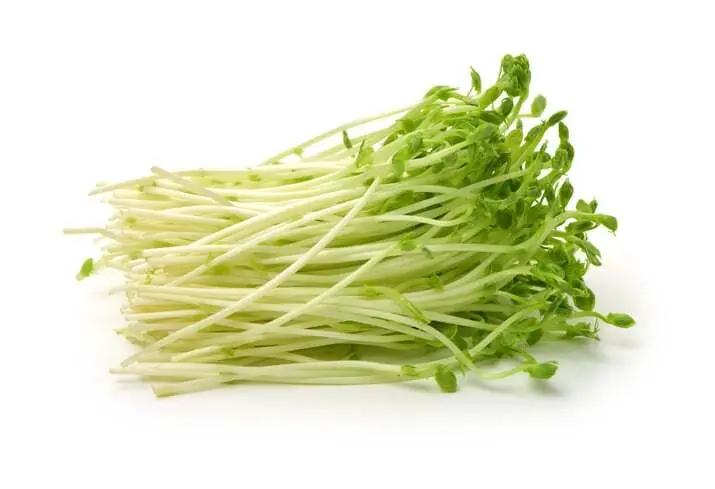Pea Microgreen Nutrition Fact Sheet

Pea Tendril (aka Pea Shoots) Powder
Pea Tendril Powder from Natural Yield is produced from our microgreen grow operations in Shailer Park, QLD. We grow the pea tendrils then freeze dry, stone-mill and pack into vacuum sealed containers.
What are Pea Tendrils?
Pea shoots, also known as pea tendrils, are the young, tender leaves, stems, and tendrils of pea plants. They are harvested in their early growth stage, typically a few weeks after the seeds have sprouted, making them a type of microgreen.
What makes Pea Tendrils special?
- Flavor: Pea shoots have a delicate, sweet, and slightly nutty flavor that resembles fresh peas. This makes them a versatile ingredient that can be used in a variety of dishes.
- Texture: They offer a crisp yet tender texture, adding a pleasant crunch to salads, sandwiches, and other dishes.
- Appearance: Pea shoots are visually appealing with their bright green leaves and curling tendrils, making them a beautiful garnish.
- Nutritional Value: Like other microgreens, pea shoots are packed with nutrients. They are a good source of vitamins A, C, and K, as well as folate, fiber, and antioxidants.
Suggested Dose of Pea Tendril Powder
All freeze dried microgreens are concentrated up to about 20x through the process of removing the water. Therefore, 1 gram of powder can equate to 5 grams of fresh microgreen. Also consider that microgreens already are typically more nutrient dense than their adult counterparts!
For adding to recipes start with small doses beginning at a teaspoon and then add to your taste preferences. We do not make any medically based recommendations however, we size the packages based on 1 teaspoon per day.
Nutrition Profile
Like other types of microgreens, pea microgreens provide many nutrients. Each serving of approximately 100 grams offers 8 grams of carbohydrates, 3 grams of fiber, 2 grams of protein, 50% of the RDA of vitamin C, and 10% of the RDA of iron, calcium, and vitamin A. They are low in calories and have no cholesterol.
Thanks to their exceptional supply of vitamin C and iron, pea microgreens provide us with the following benefits:
Strengthen the immune system: The contribution of vitamin C helps the production of white blood cells, which are responsible for fighting infections and diseases.
Improve iron absorption: Vitamin C can help improve iron absorption from food, which is especially beneficial for people who are iron deficient or anemic. Pea microgreens are ideal for combining with iron-rich foods such as lentils, green vegetables, whole grains, etc.
Thanks to their additional iron supply, they are one of the foods with the best bioavailability of this mineral. This is why they are recommended for vegetarians and vegans to replace vegetable sources.
Protect against cardiovascular diseases: Vitamin C's antioxidant function helps maintain the body's redox balance, preventing cholesterol particles from oxidizing and depositing on the arterial wall. In this way, heart attacks and strokes are prevented.
Maintain healthy skin: Vitamin C helps the production of collagen, a protein essential for skin health and other connective tissues.
Combat fatigue states: Thanks to the contribution of iron, pea microgreens help the correct transport and supply of oxygen to the cells. This helps to increase energy and reduce fatigue.
Improve cognitive function: The iron in pea microgreens is essential for cognitive function and brain development. Low iron levels can cause mental problems, such as inattention.
Finally, pea microgreens also provide a good dose of phytoestrogens, compounds with mild hormonal activity that have been shown to reduce the risk of cardiovascular disease and breast cancer. Phytoestrogens also have excellent anti-inflammatory action, which are enhanced by the action of flavonoids, polyphenols with antioxidant and anti-inflammatory activity.
All this is in addition to the superb contribution of fiber provided by pea microgreens, which is essential for maintaining a healthy intestinal microbiota and promoting proper motility and nutrient absorption.
Pea microgreens are also low in calories and can be added to salads or other dishes to add bulk to preparations for people who want to reduce body fat.
This is in addition to their fiber content, which helps control hunger between meals by providing satiety.
References
Elstrott, B., Khan, L., Olson, S., Raghunathan, V., DeLoughery, T., & Shatzel, J. J. (2020). The role of iron repletion in adult iron deficiency anemia and other diseases. European Journal of Haematology, 104(3), 153–161. https://doi.org/10.1111/ejh.13345
Ferreres, F., Esteban, E., Carpena-Ruiz, R., Jiménez, M. A., & Tomás-Barberán, F. A. (1995). Acylated flavonol sophorotriosides from pea shoots. Phytochemistry, 39(6), 1443–1446. https://doi.org/10.1016/0031-9422(95)00137-v
Hemilä, H. (2017). Vitamin C and infections. Nutrients, 9(4), 339. https://doi.org/10.3390/nu9040339
Padayatty, S. J., Katz, A., Wang, Y., Eck, P., Kwon, O., Lee, J.-H., Chen, S., Corpe, C., Dutta, A., Dutta, S. K., & Levine, M. (2003). Vitamin C as an antioxidant: evaluation of its role in disease prevention. Journal of the American College of Nutrition, 22(1), 18–35. https://doi.org/10.1080/07315724.2003.10719272
Pullar, J., Carr, A., & Vissers, M. (2017). The roles of vitamin C in skin health. Nutrients, 9(8), 866. https://doi.org/10.3390/nu9080866
Santos, J., Herrero, M., Mendiola, J. A., Oliva-Teles, M. T., Ibáñez, E., Delerue-Matos, C., & Oliveira, M. B. P. P. (2014). Assessment of nutritional and metabolic profiles of pea shoots: The new ready-to-eat baby-leaf vegetable. Food Research International (Ottawa, Ont.), 58, 105–111. https://doi.org/10.1016/j.foodres.2014.01.062
Shakoor, H., Feehan, J., Al Dhaheri, A. S., Ali, H. I., Platat, C., Ismail, L. C., Apostolopoulos, V., & Stojanovska, L. (2021). Immune-boosting role of vitamins D, C, E, zinc, selenium and omega-3 fatty acids: Could they help against COVID-19? Maturitas, 143, 1–9. https://doi.org/10.1016/j.maturitas.2020.08.003
(N.d.). Isu.edu. Retrieved April 28, 2023, from https://www.isu.edu/media/libraries/rural-health/microgreens/Microgreen-Nutritional-Profile.pdf
Disclaimer: The information provided in this article is for educational and informational purposes only and is not intended as medical advice. It is not a substitute for professional medical advice, diagnosis, or treatment. Always seek the advice of a qualified healthcare provider with any questions you may have regarding a medical condition. The author and publisher of this article are not responsible for any adverse effects or consequences resulting from the use of any suggestions, preparations, or procedures described in this article.

